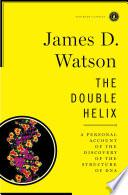
Description of Rosalind Franklin, whose data and research were actually key factors in determining the structure of DNA, but who died in 1958 of ovarian cancer, before the importance of her work could be widely recognized and acknowledged. In response to these remarks her mother stated "I would rather she were forgotten than remembered in this way." As quoted in "Rosalind Franklin" at Strange Science : The Rocky Road to Modern Paleontology and Biology by Michon Scott http://www.strangescience.net/rfranklin.htm
The Double Helix (1968)
